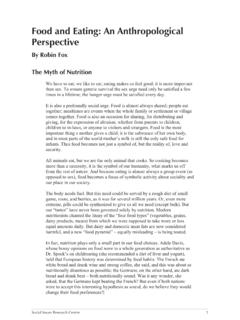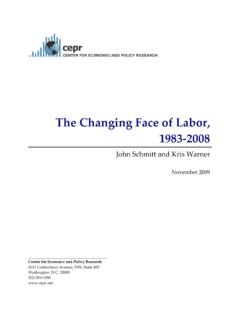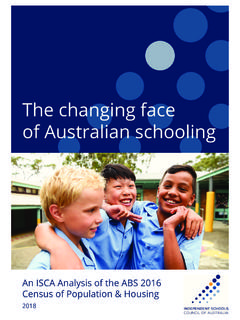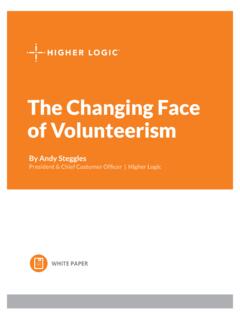Transcription of The Changing Face iof Motherhood
1 The Changing Face of Motherhood The Social Issues Research Centre 2011 Commissioned by The Social Issues Research Centre 28 St Clements Street Oxford OX4 1AB UK +44 (0) 1865 262255 The Changing Face of Motherhood Contents Summary and 1 The Changing nature of families .. 1 Divisions of labour within the family .. 1 Mothers sources of support and advice and sense of 2 Mothers relationships with their own mothers .. 2 Improving mothers lives .. 2 The 2010s the best days for Motherhood ? .. 2 1 3 The evolution of human Motherhood .. 3 The modern mother .. 3 Methods .. 4 2 How have families changed in recent history? .. 5 Family size and composition .. 5 Delayed child 5 Working mothers .. 5 The decline of the extended family?.. 6 3 Who does what in the family? .. 7 Child care and house 7 The increasing contributions of fathers the contemporary mother s view.
2 10 The impact of domestic 12 Mothers time to themselves? .. 12 The work-life balance and guilt .. 15 4 Representations of mothers in 16 5 Mothers sources of advice and support .. 19 Keeping in touch with the support network .. 20 Isolation? .. 20 6 Are mothers valued?.. 21 7 Mothers and their 23 8 What would improve mothers lives? .. 24 9 The Golden Age of Motherhood ? .. 25 10 References .. 26 Table of figures Figure 1. Mothers active involvement with their children hours per 8 Figure 2. Comparison between mothers and their mothers regarding active time with children .. 8 Figure 3. Mothers receiving help from others compared with that received by their own mothers .. 10 Figure 4. Mothers receiving help from their partners compared with that received by their own mothers.. 10 Figure 5. Who helps most in the home with child care?.. 11 Figure 6. Amount of mother s me time per 14 Figure 7.
3 Mothers me time compared with that of their own mothers .. 14 Figure 8. Reasons for more me time .. 14 The Social Issues Research Centre, March 2011 ii The Changing Face of Motherhood The Social Issues Research Centre, March 2011 iii Figure 9. Reasons for less me time .. 14 Figure 10. Feelings of guilt about the work-life 15 Figure 11. Mothers sources of advice .. 19 Figure 12. Perceptions of empowerment provide by Mumsnet, 19 Figure 13. Communicating with sources of support .. 20 Figure 14. Extent to which mothers feel isolated .. 20 Figure 15. Degree to which mothers feel valued within their families .. 21 Figure 16. Degree top which mothers feel valued by society as a 22 Figure 17. Frequency of mothers being thanked.. 23 Figure 18. How mothers would best like to be thanked.. 23 Figure 19. What would contribute an improvement in mothers 24 Figure 20. The decades to which mothers would prefer to return.
4 25 The Changing Face of Motherhood Summary and conclusions The Changing nature of families The number of households in Britain has increased substantially over the past 50 years (from 16 to 25million) but the proportion of households comprising families has fallen from 30% to 18%. Larger families, with 3 or more children, are now increasingly rare (3% of all families). At the same time, the British population is ageing . The proportion of households now containing people over the state retirement age is 28% doubling from 14% in 1961. The number of lone parents, mostly single mums, has increased substantially and lone parent families now account for a nearly a quarter of all families. Child birth is being delayed to a later age the average age of mothers at first birth is now almost 30, compared with 23 in the 1930s. These delays are partly explained by the increasing numbers of women going out work.
5 The proportion of mothers in full- or part-time employment in 1971 was around 23%. Today it is 68%. Back in 1951, only around 16% of mothers worked outside of the home. Although the role of grandparents in the family has been thought by some to be declining in recent times, 60% of additional child care in Britain is undertaken by grandparents the value to the national economy being estimated at around 4 billion. Divisions of labour within the family Today s mother with a child under the age of four spends 135 minutes per day caring for him or her and mothers generally are twice as involved in child care than fathers. Over three quarters of mothers say that they have the primary child care role. Between 2000 and 2005 the time spent on child care by mothers rose by 14%. For fathers, however, it rose by 36%. The total amount of time spent by both mothers and fathers on housework (excluding childcare) fell over this period a continuation of a trend since the 1950s and due mainly to increasing numbers of domestic labour-saving devices, convenience foods, cleaning and care products, etc.
6 Mothers are equally divided on whether they now have more time to themselves than in previous generations. Some feel that they have more me time because of labour-saving devices and help from their partners. Others feel that they have less me time due to pressures of work, children requiring more supervision and greater pressures to be an active mum . Moderate levels of guilt are experienced by mothers in their attempts to achieve a work-life balance. Today s mothers mainly feel that they spend more active time with their children than did their own mothers. They also feel that they receive more help from others, especially their husbands/partners. Both are consistent with the evidence. In the 1960s women did three quarters of all housework, including child care, averaging hours per week. Data for the 1970s and 1980s are unclear but the hours spent on housework including child care rose by 24% between 1974 and 1987.
7 The contributions made by men during the 1970s/1980s doubled, but were still well below those of mothers. It is reasonable to suppose that much of the increase in housework related to the child care element. The Social Issues Research Centre, March 2011 1 The Changing Face of Motherhood The Social Issues Research Centre, March 2011 2 The 1950s were the years in which men s attitudes to what had previously been seen as women s work began to change and their contributions began to increase. This was due mainly to the impact of the Second World War and the fact that many women had been employed during that time in occupations that were previously the preserve of men. Prior to the 1950s there is little evidence to show that fathers were actively involved in child care to any significant degree at all. Mothers sources of support and advice and sense of value The main source of advice on child rearing for today s mother is her own mother.
8 Other female friends, especially those with children of their own, are more important in this context than the husband/partner. While online social networking sites such as Mumsnet are not seen as significant sources of advice and support, they are seen as empowering mothers and are used to keep in touch with a wider network. Despite the availability of such networks and more immediate support in the family and community, many mothers feel socially isolated, especially those aged between 35 and 44. The majority of mothers feel valued by their families, but less so by society in general. While some mothers say that they are thanked by partners and/or children on a daily basis, the average frequency of being thanked is only once in 20 days. Mothers feel that being given a hug is the best way of being thanked for what they do. Mothers relationships with their own mothers There appears to have been a radical change in the nature of the relationship between mothers and their grow-up daughters who are also mothers.
9 Today, these are much more open and relaxed than in previous times. Mothers describe their relationships with their own mothers as being more like friendships than that of the traditional mother-daughter. While the ways in which mothers raise their own children have always been influenced by their own childhood experiences and the approach of their own mothers, these new styles of continuing relationship between daughters/mothers and their own mothers would seem to have a very positive impact on contemporary family life. Improving mothers lives Mothers feel that the best way of improving their lives would be greater opportunities for flexible working. More help in the home and being able to live closer to their own mothers would also contribute significantly in this context. Equal maternity/paternity leave was not seen by the majority as a major way forward. The 2010s the best days for Motherhood ?
10 While the hours spent by mothers on active child care have been steadily rising since the 1970s and before, and increasingly mothers are in paid employment outside of the home, most mothers would not want to return to family life in previous decades. While they might be happy with the 2000s, the 1990s are seen as being a decade to avoid the 1960s to the 1980s were seen as preferable. Very few would want to be a mother in the 1930s or 1940s, for very good reasons. These were the decades that, compared with the present day, and on all measures, were much harsher times for families in general, but for mothers in particular. The Changing Face of Motherhood The Social Issues Research Centre, March 2011 3 1 Introduction The evolution of human Motherhood The origins of human Motherhood date back to just under two million years ago when our most direct ancestors began to emerge as a separate species from other primates the appearance of Homo Erectus.














